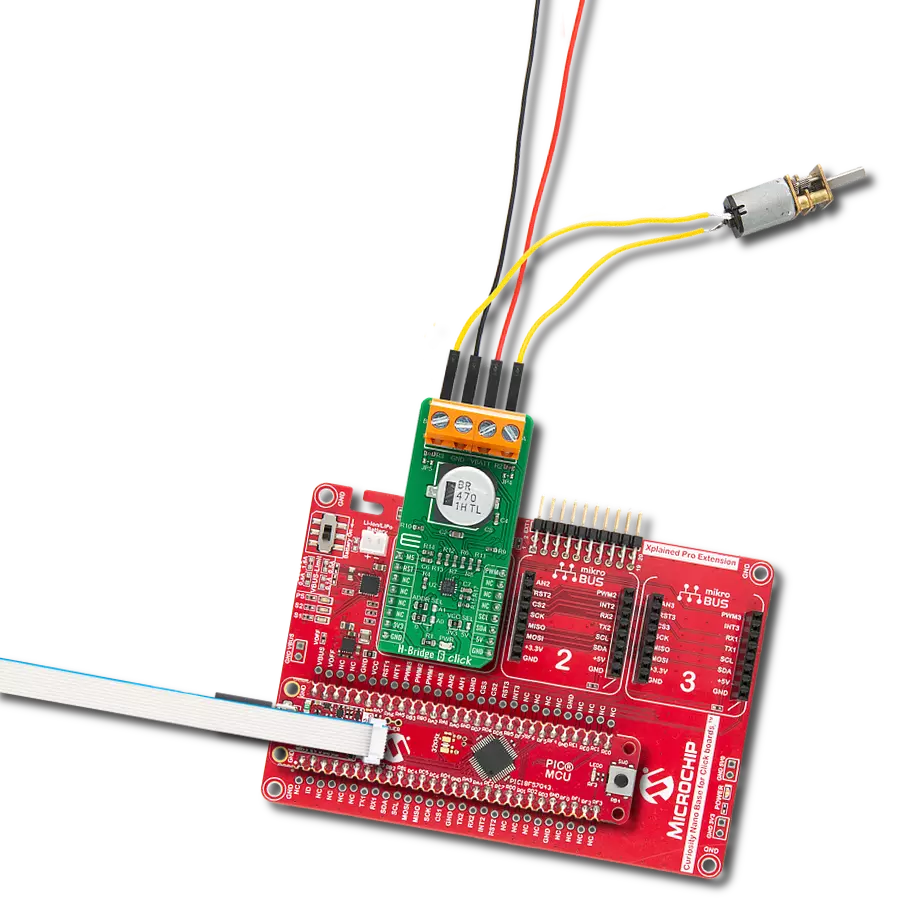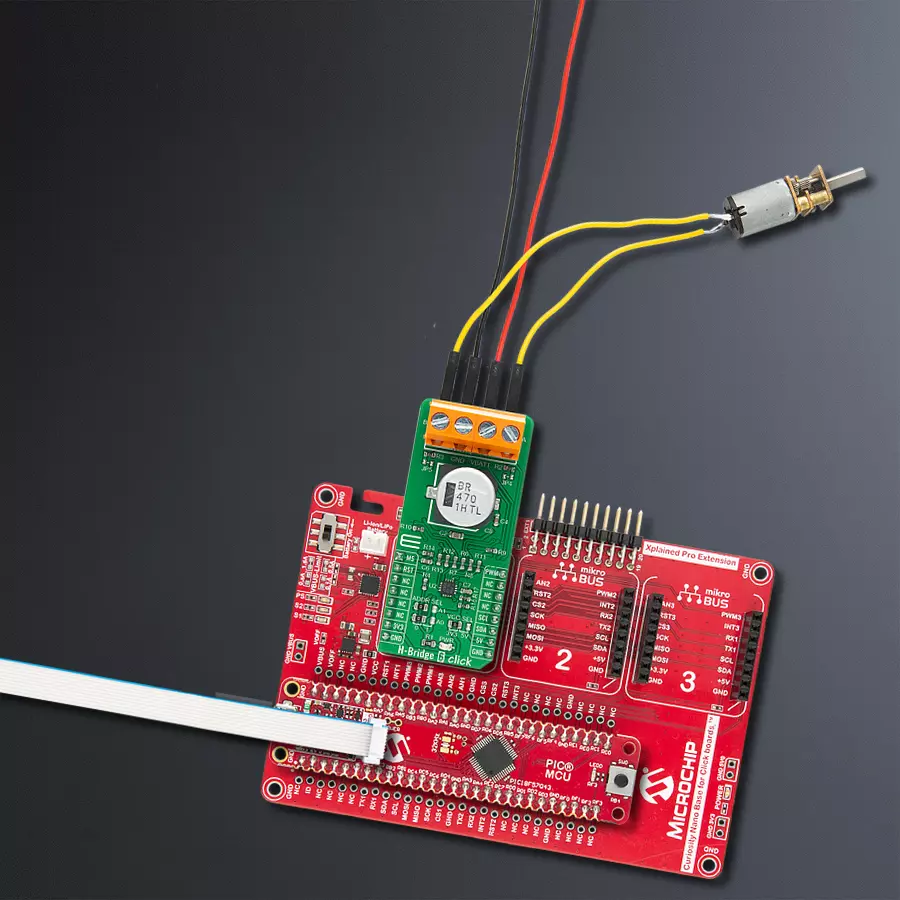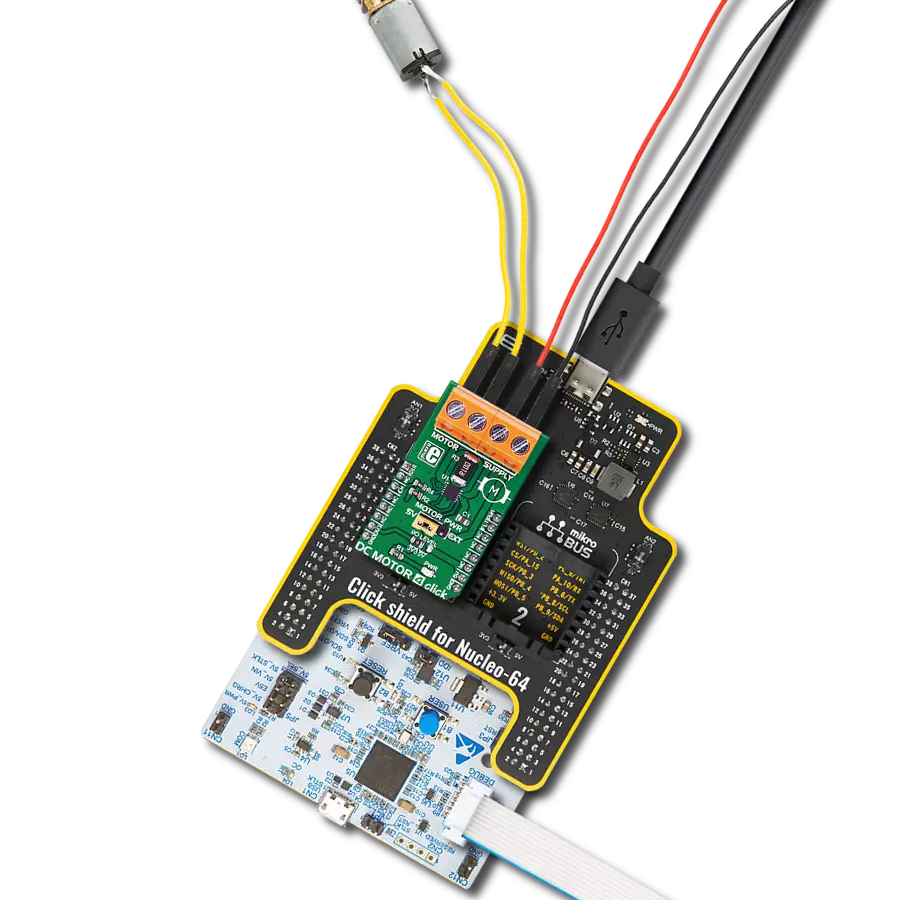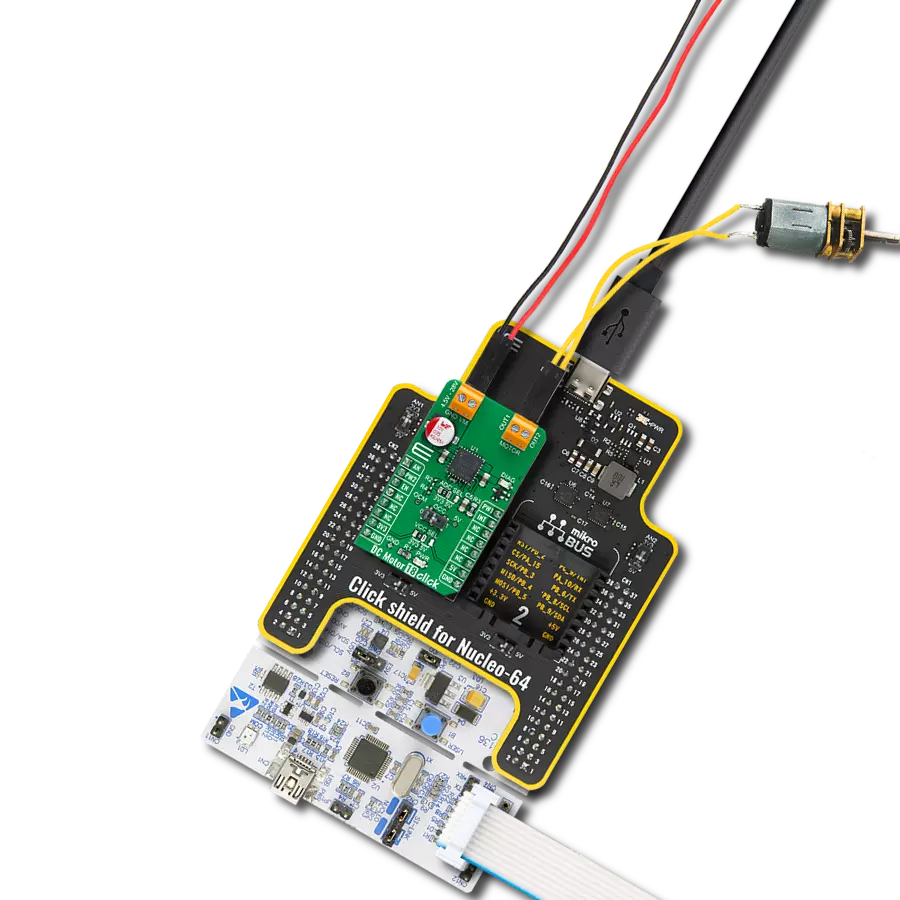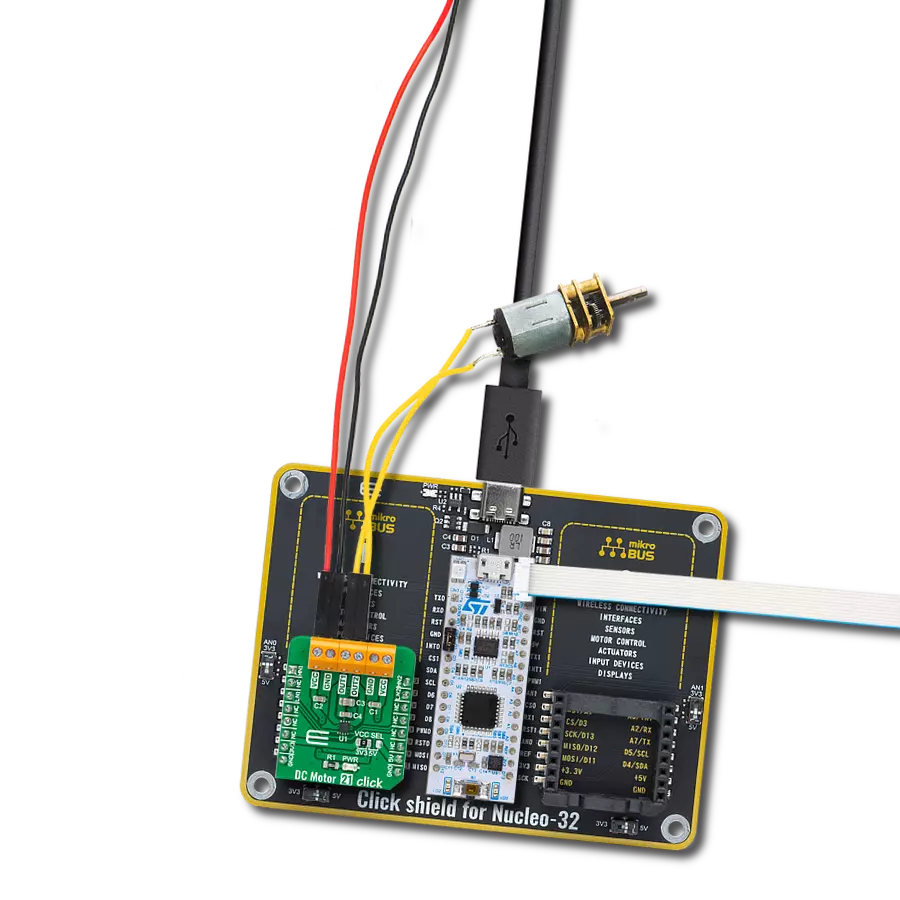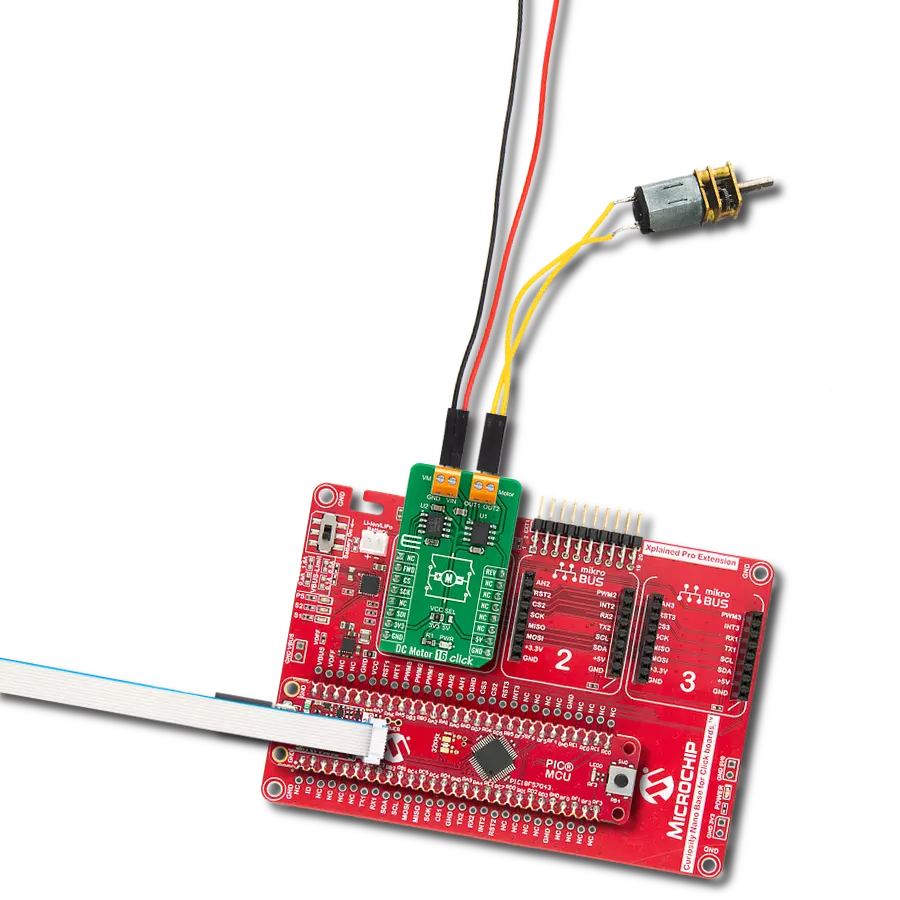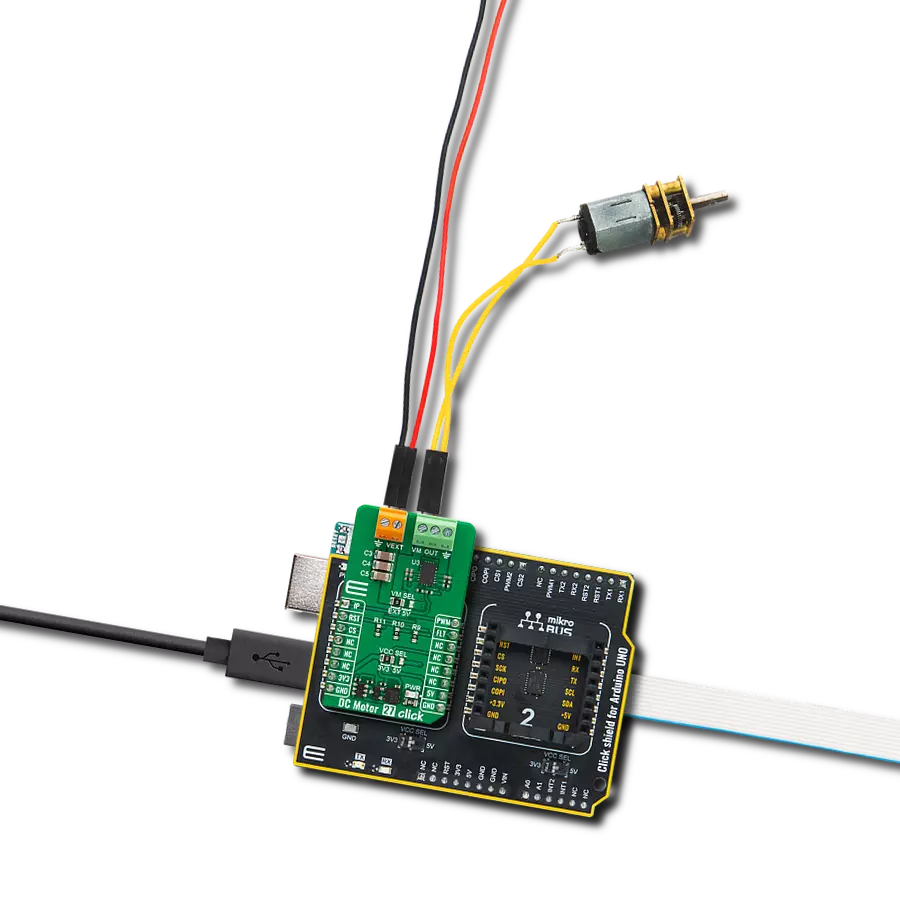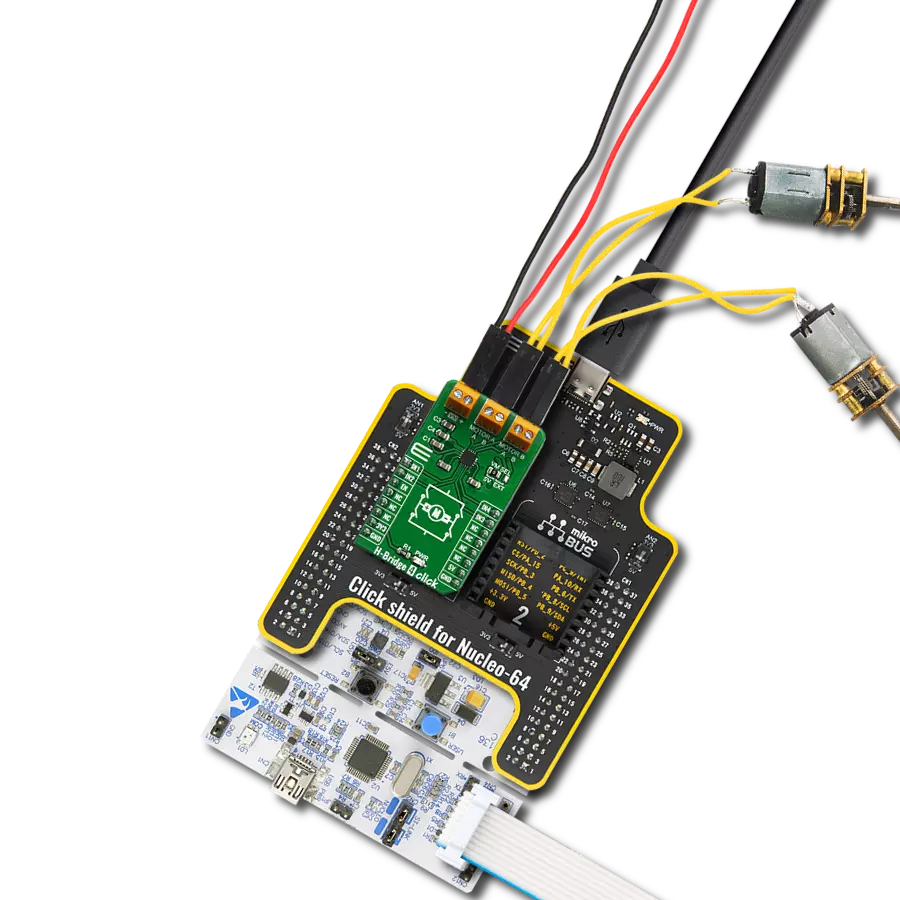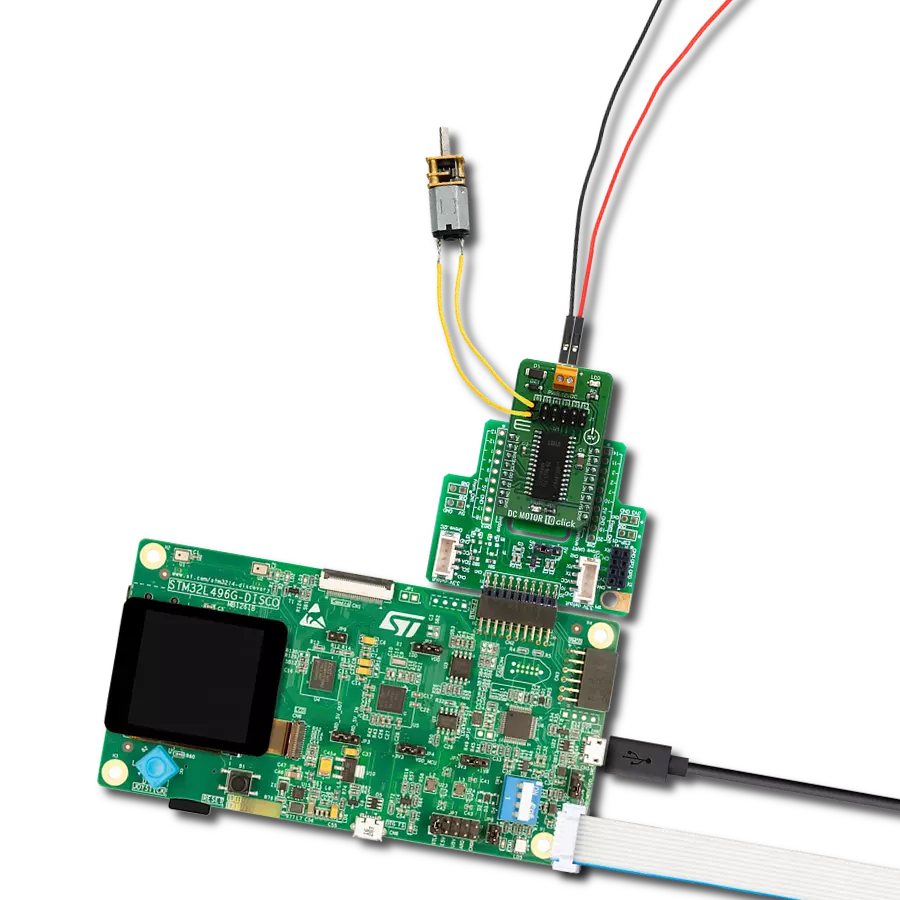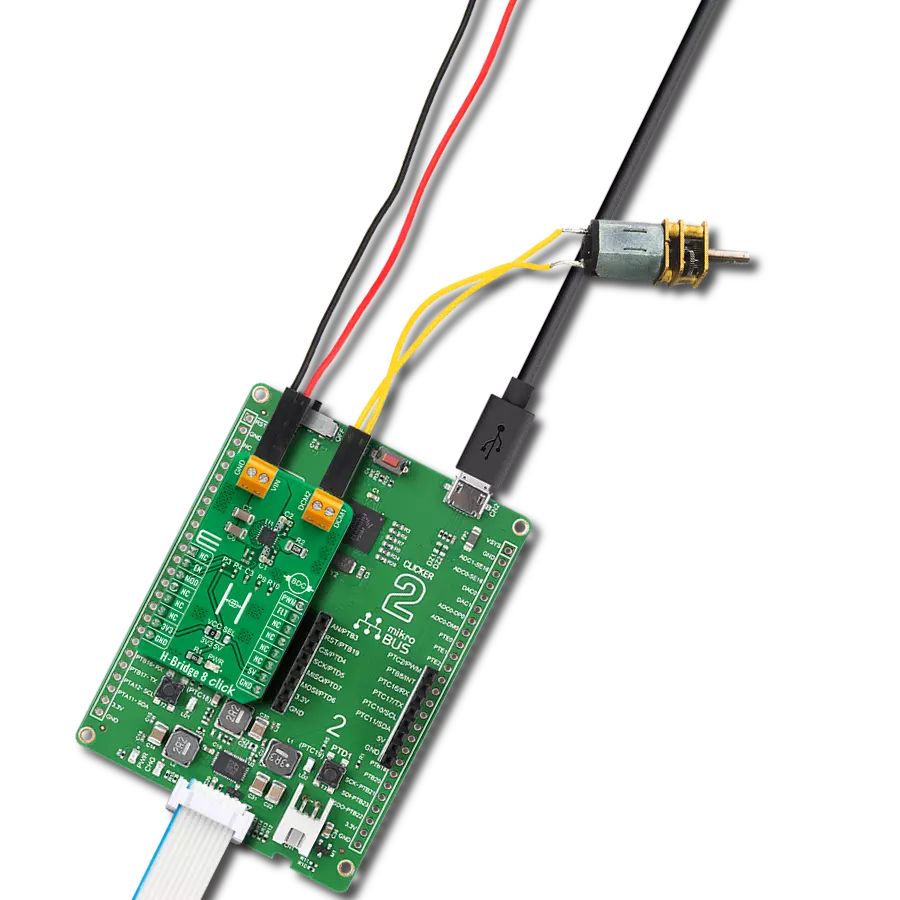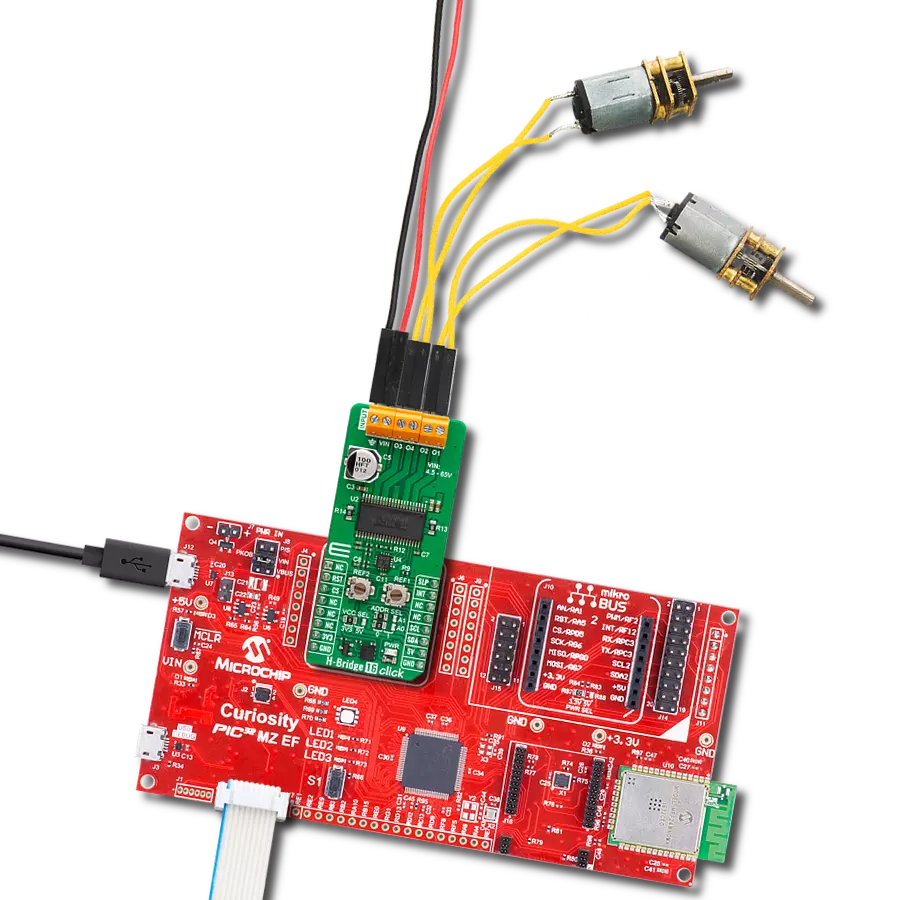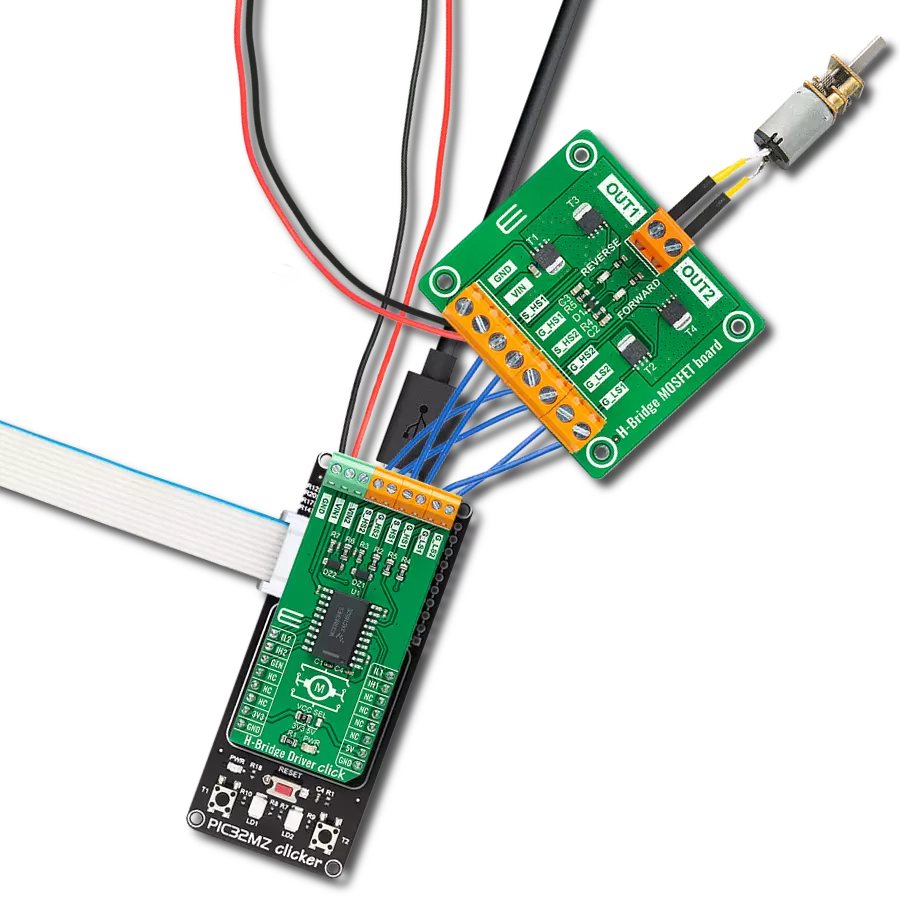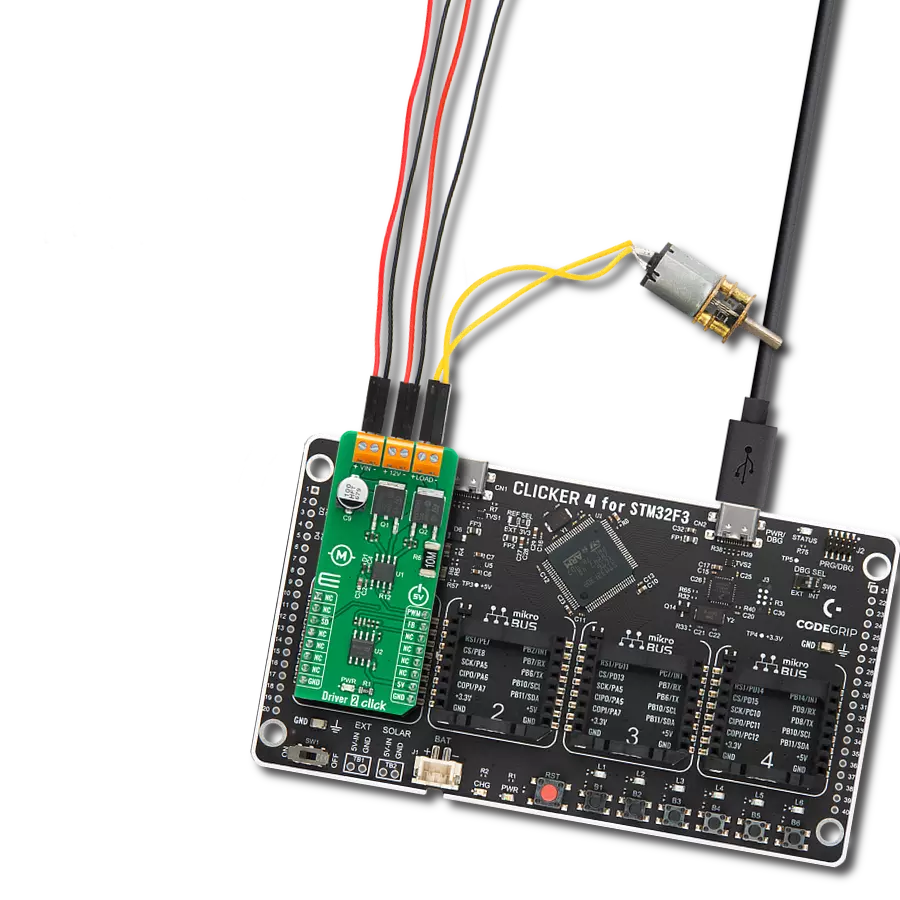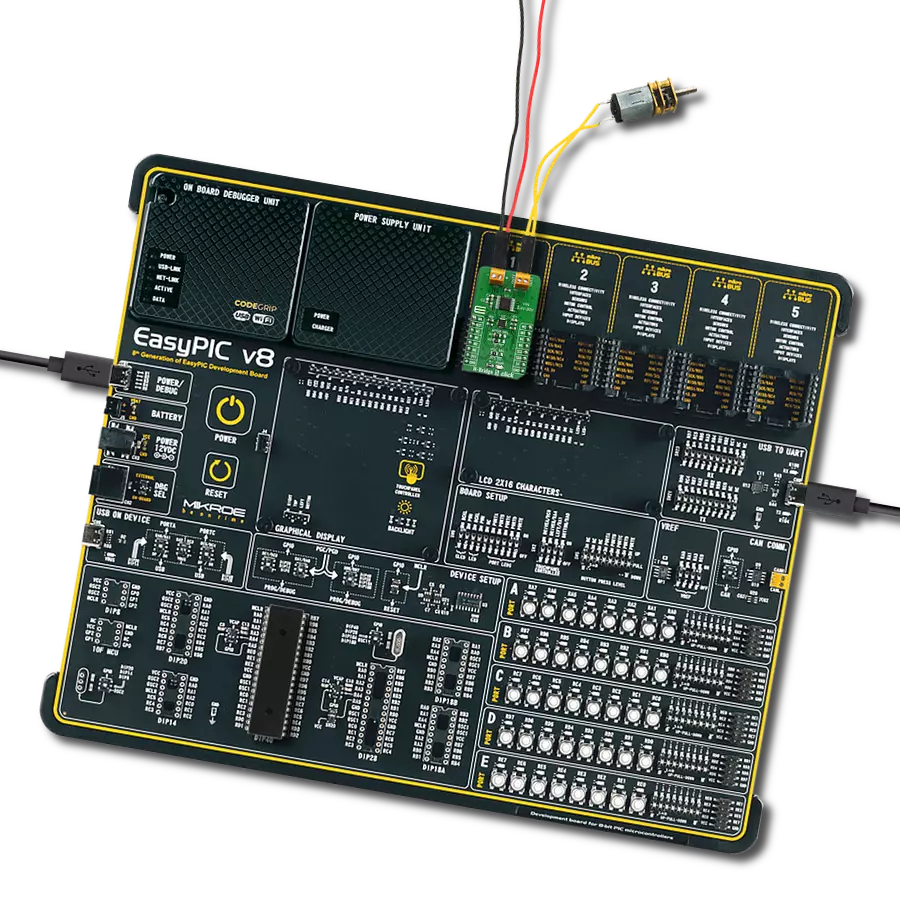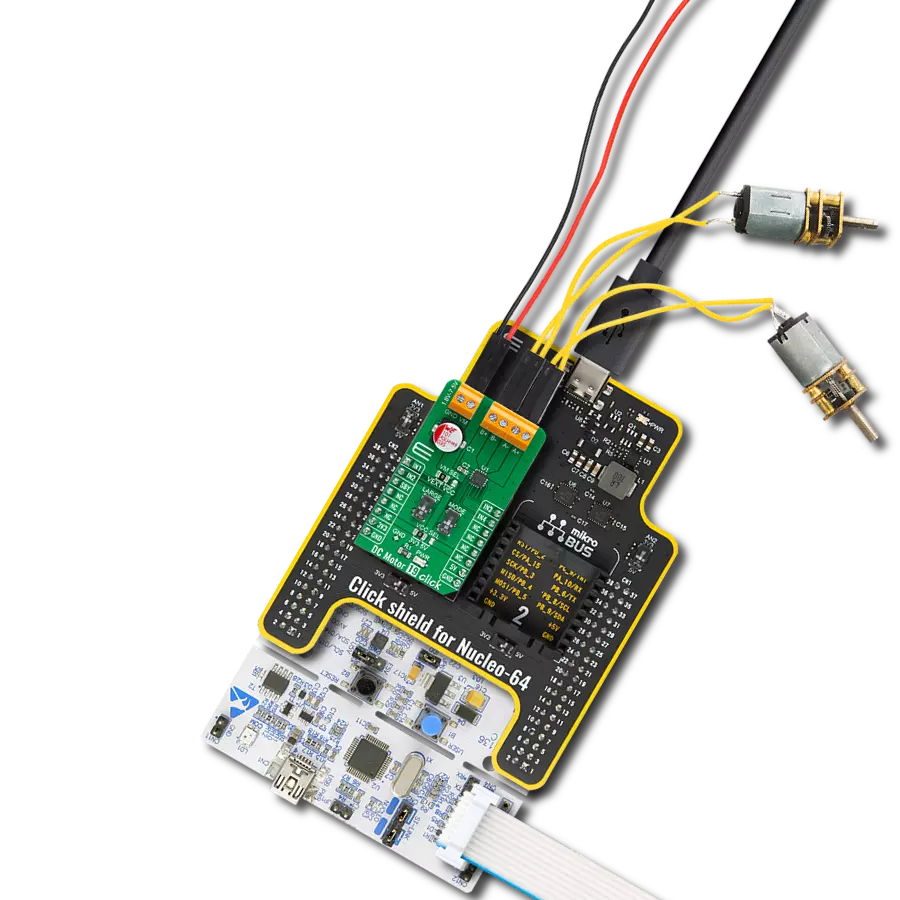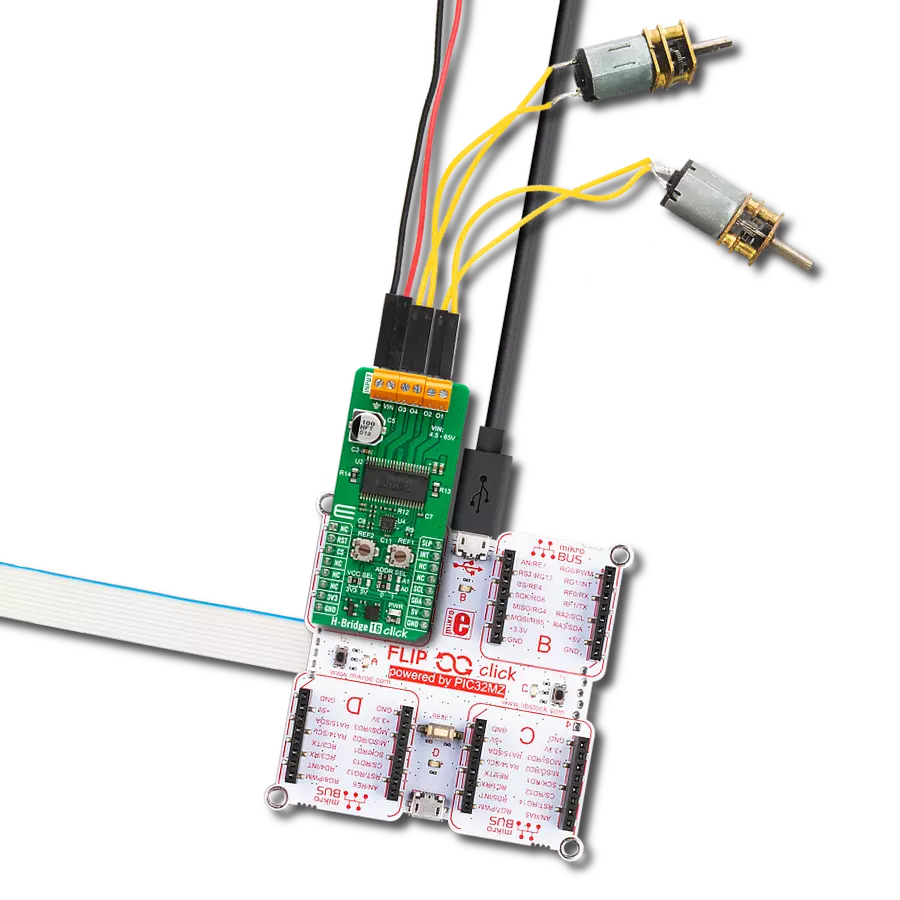Elevate your automotive experience with this advanced DC motor driving solution
A
A
Hardware Overview
How does it work?
H-Bridge 6 Click is based on the VNHD7008AY, a DC motor driver for automotive applications that integrates a fully protected dual high-side driver and protection for the external power MOSFETs from STMicroelectronics. This Click board™ can interface with the MCU to select the motor direction and the brake conditions via input signals on INA and INB pins but also possesses a MultiSense pin for a motor-current monitor. Two selection pins (SEL0 and SEL1) are available to address to the MCU the information from the MultiSense pin. It operates from a single power supply input labeled as VBATT in a range from 4V to 28V, which can be directly connected to a DC voltage supply. Also, this device is fully protected against supply under-voltage, output overcurrent, and device overtemperature events.
To Power-On the VNHD7008AY from Stand-By Mode,it is recommended to toggle INA, INB, SEL0, or SEL1 pins from 0 to 1 state to come out from Stand-By Mode. Also, toggle the PWM pin from 0 to 1 state with a delay of 20μs to avoid any overstress on the device in case of an existing short-to-battery situation. H-Bridge 6 Click communicates with MCU through a well-known 8-bit I/O expander, the PCA9538A from NXP Semiconductor, using the standard I2C 2-Wire interface with a maximum frequency of 400kHz. The VNHD7008AY also allows the choice of the least significant bit (LSB) of its I2C slave address by positioning SMD jumpers labeled as ADDR SEL to an appropriate position marked as 0 and 1. In addition to this feature, this Click board™ also contains additional functionalities routed to the PWM, AN, and RST pins on the mikroBUS™ socket.
The PWM pin, up to 20 kHz, allows to control of the speed of the motor in all possible conditions, while the AN pin labeled as MS allows monitoring of the motor current, provides a voltage proportional to the battery value, and the information on the temperature of the VNHD7008AY. The RST pin has retained its reset function by default. This Click board™ can operate with either 3.3V or 5V logic voltage levels selected via the VCC SEL jumper. This way, both 3.3V and 5V capable MCUs can use the communication lines properly. However, the Click board™ comes equipped with a library containing easy-to-use functions and an example code that can be used, as a reference, for further development.
Features overview
Development board
PIC18F57Q43 Curiosity Nano evaluation kit is a cutting-edge hardware platform designed to evaluate microcontrollers within the PIC18-Q43 family. Central to its design is the inclusion of the powerful PIC18F57Q43 microcontroller (MCU), offering advanced functionalities and robust performance. Key features of this evaluation kit include a yellow user LED and a responsive
mechanical user switch, providing seamless interaction and testing. The provision for a 32.768kHz crystal footprint ensures precision timing capabilities. With an onboard debugger boasting a green power and status LED, programming and debugging become intuitive and efficient. Further enhancing its utility is the Virtual serial port (CDC) and a debug GPIO channel (DGI
GPIO), offering extensive connectivity options. Powered via USB, this kit boasts an adjustable target voltage feature facilitated by the MIC5353 LDO regulator, ensuring stable operation with an output voltage ranging from 1.8V to 5.1V, with a maximum output current of 500mA, subject to ambient temperature and voltage constraints.
Microcontroller Overview
MCU Card / MCU

Architecture
PIC
MCU Memory (KB)
128
Silicon Vendor
Microchip
Pin count
48
RAM (Bytes)
8196
You complete me!
Accessories
Curiosity Nano Base for Click boards is a versatile hardware extension platform created to streamline the integration between Curiosity Nano kits and extension boards, tailored explicitly for the mikroBUS™-standardized Click boards and Xplained Pro extension boards. This innovative base board (shield) offers seamless connectivity and expansion possibilities, simplifying experimentation and development. Key features include USB power compatibility from the Curiosity Nano kit, alongside an alternative external power input option for enhanced flexibility. The onboard Li-Ion/LiPo charger and management circuit ensure smooth operation for battery-powered applications, simplifying usage and management. Moreover, the base incorporates a fixed 3.3V PSU dedicated to target and mikroBUS™ power rails, alongside a fixed 5.0V boost converter catering to 5V power rails of mikroBUS™ sockets, providing stable power delivery for various connected devices.
DC Gear Motor - 430RPM (3-6V) represents an all-in-one combination of a motor and gearbox, where the addition of gear leads to a reduction of motor speed while increasing the torque output. This gear motor has a spur gearbox, making it a highly reliable solution for applications with lower torque and speed requirements. The most critical parameters for gear motors are speed, torque, and efficiency, which are, in this case, 520RPM with no load and 430RPM at maximum efficiency, alongside a current of 60mA and a torque of 50g.cm. Rated for a 3-6V operational voltage range and clockwise/counterclockwise rotation direction, this motor represents an excellent solution for many functions initially performed by brushed DC motors in robotics, medical equipment, electric door locks, and much more.
Used MCU Pins
mikroBUS™ mapper
Take a closer look
Click board™ Schematic

Step by step
Project assembly
Software Support
Library Description
This library contains API for H-Bridge 6 Click driver.
Key functions:
void hbridge6_generic_write ( uint8_t reg, uint8_t tx_data )- Generic write function.uint8_t hbridge6_generic_read ( uint8_t reg )- Generic read function.void hbridge6_set_direction ( uint8_t direction )- Set the direction function.
Open Source
Code example
The complete application code and a ready-to-use project are available through the NECTO Studio Package Manager for direct installation in the NECTO Studio. The application code can also be found on the MIKROE GitHub account.
/*!
* @file main.c
* @brief HBridge6 Click example
*
* # Description
* This is an example that demonstrates the use of H-Bridge 6 Click board.
*
* The demo application is composed of two sections :
*
* ## Application Init
* Initialization driver enables - I2C,
* reset the device and set default configuration,
* initialization and configure the PWM, also write log.
*
* ## Application Task
* It shows moving in the clockwise direction of rotation
* and moving in the counterclockwise direction of rotation
* from slow to fast speed.
* All data logs write on USB uart changes.
*
* @author Stefan Ilic
*
*/
#include "board.h"
#include "log.h"
#include "hbridge6.h"
static hbridge6_t hbridge6;
static log_t logger;
void application_init ( void ) {
log_cfg_t log_cfg; /**< Logger config object. */
hbridge6_cfg_t hbridge6_cfg; /**< Click config object. */
/**
* Logger initialization.
* Default baud rate: 115200
* Default log level: LOG_LEVEL_DEBUG
* @note If USB_UART_RX and USB_UART_TX
* are defined as HAL_PIN_NC, you will
* need to define them manually for log to work.
* See @b LOG_MAP_USB_UART macro definition for detailed explanation.
*/
LOG_MAP_USB_UART( log_cfg );
log_init( &logger, &log_cfg );
log_info( &logger, " Application Init " );
// Click initialization.
hbridge6_cfg_setup( &hbridge6_cfg );
HBRIDGE6_MAP_MIKROBUS( hbridge6_cfg, MIKROBUS_1 );
err_t init_flag = hbridge6_init( &hbridge6, &hbridge6_cfg );
if ( I2C_MASTER_ERROR == init_flag || PWM_ERROR == init_flag ) {
log_error( &logger, " Application Init Error. " );
log_info( &logger, " Please, run program again... " );
for ( ; ; );
}
log_printf( &logger, "-----------------------\r\n" );
log_printf( &logger, " Set default config. \r\n" );
log_printf( &logger, "-----------------------\r\n" );
hbridge6_default_cfg( &hbridge6 );
Delay_ms ( 100 );
log_info( &logger, " Application Task " );
}
void application_task ( void ) {
static int8_t duty_cnt = 1;
static int8_t duty_inc = 1;
float duty = 0;
log_printf( &logger, " Clockwise \r\n" );
log_printf( &logger, "-----------------------\r\n" );
hbridge6_set_direction( &hbridge6, HBRIDGE6_DIRECTION_CLOCKWISE );
while ( duty_cnt < 10 ) {
duty = duty_cnt / 10.0;
hbridge6_set_duty_cycle ( &hbridge6, duty );
Delay_ms ( 500 );
duty_cnt += duty_inc;
}
log_printf( &logger, " Brake \r\n" );
log_printf( &logger, "-----------------------\r\n" );
hbridge6_set_direction( &hbridge6, HBRIDGE6_DIRECTION_BRAKE );
duty_cnt = 1;
Delay_ms ( 1000 );
log_printf( &logger, " Counterclockwise \r\n" );
log_printf( &logger, "-----------------------\r\n" );
hbridge6_set_direction( &hbridge6, HBRIDGE6_DIRECTION_COUNTERCLOCKWISE );
while ( duty_cnt < 10 ) {
duty = duty_cnt / 10.0;
hbridge6_set_duty_cycle ( &hbridge6, duty );
Delay_ms ( 500 );
duty_cnt += duty_inc;
}
log_printf( &logger, " Brake \r\n" );
log_printf( &logger, "-----------------------\r\n" );
hbridge6_set_direction( &hbridge6, HBRIDGE6_DIRECTION_BRAKE );
duty_cnt = 1;
Delay_ms ( 1000 );
Delay_ms ( 1000 );
Delay_ms ( 1000 );
hbridge6_pwm_stop( &hbridge6 );
Delay_ms ( 1000 );
Delay_ms ( 1000 );
hbridge6_pwm_start( &hbridge6 );
}
int main ( void )
{
/* Do not remove this line or clock might not be set correctly. */
#ifdef PREINIT_SUPPORTED
preinit();
#endif
application_init( );
for ( ; ; )
{
application_task( );
}
return 0;
}
// ------------------------------------------------------------------------ END
Additional Support
Resources
Category:Brushed
